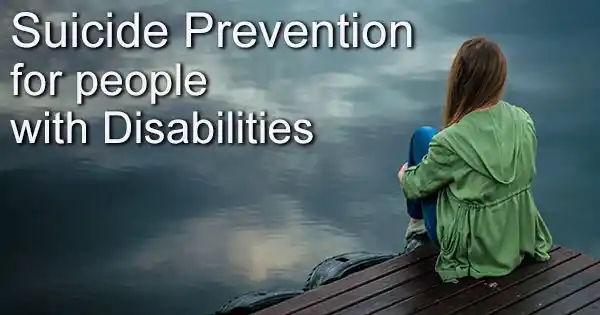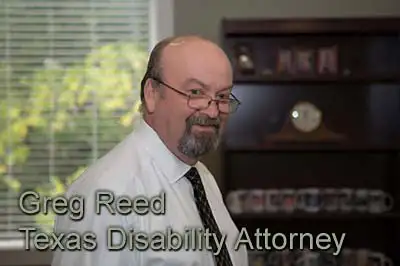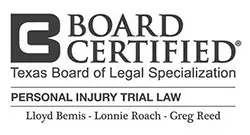Suicide concerns and prevention for those with disabilities
Life can get very difficult at times and it’s very important to watch for warning signs and get help when needed.
Author Attorney Greg Reed:
Suicide is the 10th leading cause of death in the United States. According to the World Health Organization, approximately 1 million people die each year from suicide.

Anyone can be at risk for suicide but for the disabled life can be particularly challenging. Suicide prevention begins with recognizing the warning signs and taking them seriously.
It may be difficult for people who are not experiencing despair or depression to understand why someone would want to take their own life, but to a suicidal person in unbearable pain, suicide is the only way to escape their suffering.
Depression and substance abuse are the most common causes of suicide, but having a serious health condition or disability may increase the risk of suicide.
Anyone can be at risk for suicide.
Suicide occurs when a person can no longer cope with stress they are experiencing in their life.
In addition to depression and substance abuse, risk factors include:
- Bipolar disorder
- Schizophrenia
- Anxiety disorders
- Serious physical health conditions
- Traumatic brain injury
- Access to lethal drugs and firearms
- Prolonged stress – unemployment, bullying, relationship problems
- Stressful life events such as a death, divorce or financial difficulties
- Exposure to another person’s suicide
- Family history of suicide
If you have been denied disability don’t give up! Contact a Disability lawyer at 512-454-4000 for a free consultation and get the benefits you deserve.
Healthcare facilities such as primary care, emergency rooms, behavior health care programs and substance abuse treatment centers play an important role in preventing suicide by identifying suicide risk and providing timely care, but friends and family also share in that role.
Preventing suicide requires a combination of steps to address the problem. The first step is to know the warning signs and identify an individual who is at risk.
A person who is at risk of attempting suicide may exhibit any of the following behaviors:
- Talk about wanting to die or kill themselves
- Look for a way to attempt suicide by searching online or obtaining a gun
- Talk about feeling hopeless or being in pain
- Increase their use of drugs or alcohol
- Act anxious or behave recklessly
- Withdraw from their usual activities
- Display extreme mood swings
- Give away prized possessions
- Sleep too little or too much
Treatment for those who have attempted suicide or considered it involves teaching individuals to recognize when they need help and provide access to effective mental health care.
Those experiencing severe emotional distress may need a variety of services including hotlines, psychiatric care, emergency care, and peer support groups. People in crisis must be prevented from obtaining lethal means of self-harm; safely storing medications and firearms, installing gun safety locks and changing medication packaging are all important measures which should be taken. The goal of treatment is to prepare people to meet challenging life situations such as economic stress, divorce, or physical illness and develop optimism and a positive self-concept.
A suicidal person may not ask for help, but that doesn’t mean they don’t want help.
Suicide prevention begins with recognizing the warning signs and taking them seriously. If you believe a family member or friend is considering suicide, it might be difficult to bring up the subject, but talking openly about suicidal feelings can save a life.
- If you are concerned, speak up. Say something like, “I’ve been concerned about you lately and wondered how you are doing.”
- Ask “Are you having thoughts of suicide?”
- Let the person know they are not alone and their life is important to you.
- Ask how you can support them.
- Listen and let the suicidal person vent.
- Be sympathetic, calm, patient and non-judgmental.
- Reassure the person that help is available and these feeling are temporary.
A person with a disability may not only experience isolation leading to depression, but struggle with how to respond to society’s perception of their disability.
According to Thomas Weiss in his article, “People with Disabilities and Suicide Awareness,” most disabled people who commit suicide aren’t driven to it by the experience of having a disability; but these tendencies are due to “difficulty in knowing how to navigate society’s perception of disability and how that perception impacts their relationships and livelihood. It is especially difficult for people who become disabled after living a life free from disability.” LiveOn.net is an anti-suicide campaign directed to people with disabilities who may be at risk of suicide. The website, run by people have disabilities, contains videos of individuals telling their stories and encouraging others with disabilities to Live On.
September was Suicide Prevention month, but suicide can happen any day. For more information on how you can help, see https://www.helpguide.org/articles/suicide-prevention/suicide-prevention.htm.
Disability benefits are an important source of income for those who are unable to work. If you not able to work due to accident or illness, you may be eligible for Social Security Disability or Long Term Disability benefits. If you have applied for benefits and been denied, contact the attorneys at Bemis, Roach and Reed for a free consultation. Call 512-454-4000 and get help NOW.
Author: Attorney Greg Reed has been practicing law for 29 years. He is Superlawyers rated by Thomson Reuters and is Top AV Preeminent® and Client Champion Gold rated by Martindale Hubbell. Through his extensive litigation Mr. Reed obtained board certification from the Texas Board of Legal Specialization. Greg is admitted to practice in the United States District Court - all Texas Districts and the United States Court of Appeals-Fifth Circuit. Mr. Reed is a member of the Travis County Bar Association, Texas Trial Lawyers Association, past Director of the Capital Area Trial Lawyers Association, and an Associate member of the American Board of Trial Advocates. Mr. Reed and all the members of Bemis, Roach & Reed have been active participants in the Travis County Lawyer referral service.
Your Free Initial Consultation
Call now:
At Bemis, Roach and Reed, if we can't help you, we will try to find the right attorneys for you.
We offer each of our prospective clients a free no obligation one hour phone or office consultation to see if we can help you and if you are comfortable with us. We know how difficult a time like this can be and how hard the decisions are. If we can be of assistance to you and help you find a solution to your issue we will even if that means referring you to another attorney.
Let's get you Started:
If you could provide us with some basic information about your claim we will get right back with you with a free case evaluation and schedule your Free Consultation Today.








